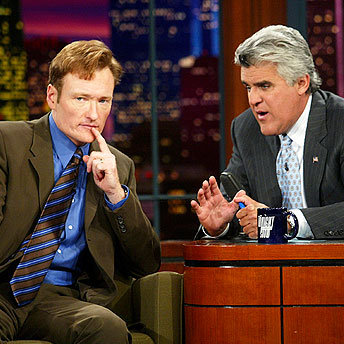The rumors have been flying for weeks. We all knew it was coming. And now it’s here: WEEK has taken over the operation of WHOI:
March 2, 2009 – Granite Broadcasting Corporation and Barrington Broadcasting Group, LLC announced that, effective March 2, 2009, WEEK-TV and WHOI-TV will be operated jointly from the WEEK-TV studios in East Peoria, Illinois. Granite will operate both stations under a shared services agreement (SSA) with Barrington, owner of WHOI-TV.
Under the terms of the agreement, Granite will continue to operate WEEK-TV and provide advertising, sales, promotion, administrative services and selected programming to WHOI-TV. This arrangement between Granite and Barrington will create a better and more efficient operation, which will enhance these outstanding local television stations. A similar arrangement provides that Barrington will provide advertising, sales, promotion, administrative services and selected programming to Granite’s Syracuse, New York station, WTVH-TV.
In making this announcement, Granite Broadcasting’s Chief Executive Officer Don Cornwell said, “This arrangement is an important step in the implementation of Granite’s strategic vision to capitalize on our core strength of operating leading local stations in the nation’s mid-size markets. It provides opportunities for substantial operating efficiencies by allowing us to use our existing infrastructure to expand the breadth of local news and services provided to the viewers of Central Illinois, while enhancing the revenue and profitability of both stations.”
Barrington Chief Executive Officer Jim Yager stated, “We are delighted to be working with a forward-thinking company like Granite. Together, our companies and stations will focus our combined resources on making these great stations more efficient, becoming even better community citizens and, at the same time, providing measurable benefits for our viewers.”
Under the terms of the SSA, Granite and Barrington expect to realize a number of expense efficiencies through the combining of resources and the reduction of some staff positions. Affected employees will receive a generous severance package and extensive job placement assistance will be offered at company expense.
One of the chief advantages of operating WEEK and WHOI under a shared services agreement will be the ability to offer local and national news, as well as programming of community interest in new and varied time periods, giving viewers greater opportunity to watch at their convenience. The Granite and Barrington plan will fully develop this opportunity, offering local newscasts expanded in both breadth and amount. Specifically, the stations will provide newscasts in time periods not currently programmed with local news and extend local news to other time periods, allowing viewers more access to Central Illinois reports and information. Another Granite objective is to improve the emergency weather forecasting and daily forecasting by bringing the latest and best technology to both stations. New programs focusing on all important medical issues and franchise segments highlighting critical issues of public service will also be added to the stations in the next few weeks.
In addition, community charitable organizations presently on either WEEK or WHOI will receive increased exposure using the power of the two stations working together. One example is WEEK’s highly successful Buddy Check and Prostate Awareness programs. Also, the St. Jude Telethon, now in its 35th year on WEEK, will air on both stations. Another is the 25 Women In Leadership program. WHOI’s One Class at a Time, Relay for Life and special programs for the Peoria Zoo, along with numerous other community programs will continue. The stations will now concentrate on these highly popular outreach campaigns to further drive the focus on those deserving of recognition within the community.
Other plans include production of town hall meetings and a variety of community forums on WEEK and WHOI stations at different times, so viewers have greater access to information of local relevance. Granite also will expand its policy of sponsoring political debates and offering free airtime to candidates in every national election on both of the stations.
So now, although we have five commercial station owners, we have only two commercial station operators. And so, practically speaking, we have only two local TV news organizations now. One is the WEEK/WHOI/WAOE organization and the other is the WMBD/WYZZ organization. I fail to see the benefit to the Peoria area of all this media consolidation.
UPDATE: Here’s some more information on personnel and schedules from WEEK’s site:
For you viewers, here are the changes, HOI-19’s early news moves to 5:30 p.m. Then ABC’s World News Tonight on WHOI moves to 6:00 p.m., providing nightly national news so those working later now have access to the national and international information in a new and more convenient time period.
News 25 at 5:00 and 6:00 p.m. stays the same as will the morning and 10 p.m. newscasts on both stations. Jen Christensen will continue to anchor HOI-19’s newscasts and HOI-19’s popular Sports Director Jim Mattson will join forces with News 25’s Lee Hall to make up the best and most aggressive sports team in Central Illinois. News 25’s popular Weather Man Lee Ranson will give the forecasts for both stations.
The two stations will produce newscasts with the combined staffs of both broadcast teams.
 Nexstar Broadcasting Group, owner of WMBD channel 31, entered into an outsourcing agreement with Sinclair Broadcast Group, owner of WYZZ channel 43, on December 1, 2001. In April 2002, WYZZ added a 9 p.m. newscast, produced by WMBD’s news department.
Nexstar Broadcasting Group, owner of WMBD channel 31, entered into an outsourcing agreement with Sinclair Broadcast Group, owner of WYZZ channel 43, on December 1, 2001. In April 2002, WYZZ added a 9 p.m. newscast, produced by WMBD’s news department.
 I don’t generally cover entertainment news on my blog, but for whatever reason, I’ve been obsessed lately with the whole Tonight Show debacle on NBC.
I don’t generally cover entertainment news on my blog, but for whatever reason, I’ve been obsessed lately with the whole Tonight Show debacle on NBC.